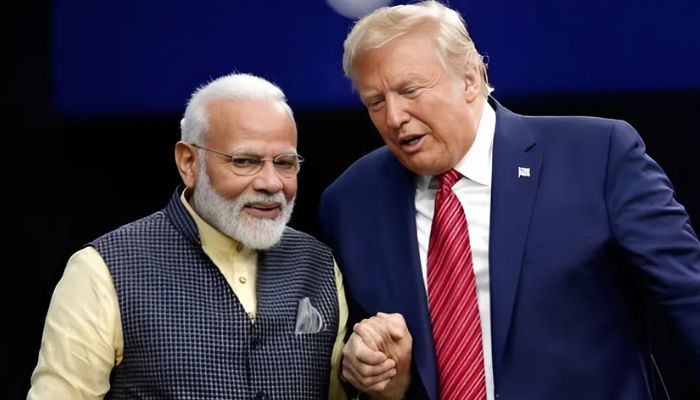Trump’s olive branches and Navarro’s rants: How India has been dealing with a confused, dual-faced US leadership amid trade talks and tariff chaos
By Anurag
Copyright opindia

On 9th September, Prime Minister Narendra Modi and United States President Donald Trump exchanged messages that, at least on the surface, looked like a renewal of old camaraderie. PM Modi described India and the US as “close friends and natural partners” and stressed that trade talks could unlock “limitless potential” in the partnership. His message came in response to Trump’s post on Truth Social where he said he was “pleased” about negotiations to resolve trade barriers and called PM Modi his “very good friend”. He also predicted that there would be “no difficulty” in reaching a successful conclusion.
India and the US are close friends and natural partners. I am confident that our trade negotiations will pave the way for unlocking the limitless potential of the India-US partnership. Our teams are working to conclude these discussions at the earliest. I am also looking forward… pic.twitter.com/3K9hlJxWcl— Narendra Modi (@narendramodi) September 10, 2025
This rosy language from the US President came even as Washington has doubled tariffs on Indian goods, with threats of more to come. Interestingly, while posting messages in an attempt to woo New Delhi, Trump reportedly urged the European Union to follow suit and slap tariffs of up to 100% on imports from India and China, claiming that it would weaken Russia. So, while Trump speaks the language of friendship, the policies his camp advances look very different.
Navarro’s tantrums on social media
Trump’s trade aide Peter Navarro, who has turned his social media feed into an extended rant against India, recently labelled India the “Maharaja of tariffs”. He accused India of fuelling Russia’s war chest by buying discounted oil and mocked Indian students for “flooding” American schools. He even claimed that Indian users were hijacking X’s Community Notes feature to bury facts, a conspiracy theory he floated without any basis.
🧵 India’s keyboard minions are hijacking X’s Community Notes to bury the facts.They’re furious about losing unfettered access to U.S. markets—even as India, the Maharaja of Tariffs, keeps some of the world’s highest trade barriers. pic.twitter.com/d72WoebqIa— Peter Navarro (@RealPNavarro) September 9, 2025
Navarro’s attacks are not just about economics. They drip with the kind of rhetoric that has been seen exported from sections of the Indian opposition. Navarro even dabbled in caste politics, parroting tropes about Brahmins profiteering, rhetoric that has little to do with trade policy but plenty to do with resentment. In short, while Trump is offering olive branches, Navarro is busy lashing out at India in ways that sound more like propaganda than policy.
India refuses to bend on core issues
What explains the anger? The answer lies in New Delhi’s refusal to compromise where it matters most. India has made it clear that its energy security cannot be dictated by Washington’s sanctions regime. Imports of Russian crude have jumped since 2021, reaching over $67 billion in 2024, with about $53 billion of that being oil. Navarro cites this as evidence of profiteering. However, India has consistently argued that Western nations themselves continue to trade with Russia and it cannot be expected to jeopardise its development trajectory because of someone else’s war.
The same principle applies to tariffs. India has always maintained that trade must be balanced, not one-sided. Agricultural imports, dairy, and digital services taxes are not bargaining chips to be surrendered under American pressure. New Delhi has insisted on protecting domestic industries, which has been portrayed by Washington as protectionism. India, on the other hand, sees it as common sense. But common sense is not so common, which is visible in the frustration Washington has shown towards India in the past few months.
The double-speak of American leadership
The contrast could not be clearer. Trump’s conciliatory posts emphasise friendship and a brighter future, yet his administration’s actions while Navarro continues with his inflammatory rhetoric tell a story of threats, coercion, and disdain. It is evident that the US wants India to reduce duties and open its markets wider, but at the same time pushes for punitive tariffs of its own. It wants India to cut Russian oil imports, yet its European allies continue buying Russian energy quietly. It complains about a trade deficit, but conveniently ignores the billions earned from Indian students and tourists in America each year. It wants India to leave BRICS claiming it is anti-America but India has bluntly rejected it.
This cannot be seen as diplomacy but as double-speak. On one hand, Trump wants to appear the statesman capable of resolving trade disputes amicably. On the other hand, his aides and his policy announcements keep the stick raised, hoping India will blink first, which has not happened despite immense pressure from the Trump administration.
India’s counter-strategy
The US has failed to force India to bend. Instead, India is rolling out relief packages to cushion exporters, adjusted GST rates to stimulate demand, and accelerated negotiations for free trade agreements with partners in Europe, Latin America, Africa, and Southeast Asia. The message is deliberate, that India will not get cornered into submission and will continue diversifying its markets to reduce reliance on any one partner.
Markets may feel the short-term pain, with sectors like textiles and agriculture hit hardest by US tariffs, but India’s broader strategy is to play the long game. By maintaining energy stability through Russian imports and forging new trade corridors, it ensures resilience even in the face of American hostility.
The obsession with tariffs and deficits
Navarro has repeatedly cried about tariffs costing American jobs or deficits hollowing out US industries while ignoring an obvious reality. Trade deficits are not proof of exploitation. They are part of global supply chains in which consumers benefit from lower costs and businesses thrive through expanded markets. Yet, Navarro continues to spin the narrative as if every dollar India earns is a dollar stolen from American workers. It is rhetoric designed to inflame, not to inform.
What makes his attacks even more hollow is that Trump himself has admitted in the past that India is a “tough negotiator,” even if a friend. If toughness in negotiation is a crime, then surely every nation that protects its interests is guilty.
Russia, tariffs and the real irritation
What angers Washington most is not just tariffs but India’s independent streak. New Delhi has made it clear it will not be dragged into blocs or dictated to on its foreign policy. India has refused to toe the Western line on Russia and insisted on its right to craft trade policy in line with national priorities. By doing this, India has sent the unmistakable message that it is a partner, not a client state.
This is what Navarro cannot digest, and what Trump tries to cover up with sugary words. The very fact that both messages are being delivered simultaneously, one of friendship, the other of fury, shows a leadership torn between recognising India’s importance and resenting its autonomy.
What is being seen today is a confused American posture. One hand extends an olive branch, the other wields the tariff stick. One voice speaks of friendship, another rants about India profiteering. Through it all, India has remained consistent, that is, protect sovereignty, secure energy needs, and negotiate from strength, not fear.
For Washington, this duality may serve short-term political goals. However, for India, it only reinforces the importance of sticking to principle. The US may rant about deficits and tariffs, but New Delhi will not barter away its autonomy. Trump’s olive branches may soften the rhetoric, Navarro’s rants may sharpen it, yet neither changes the simple reality that India will chart its own course, on its own terms, no matter how chaotic the American messaging becomes.



